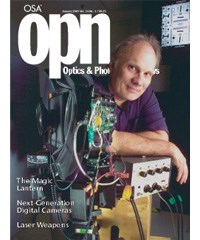
January 2003 Issue
Feature Articles
Fighting Terrorism or Red Tape?
A Florida optics company encounters an unexpected obstacle in its attempt to market a spectrometry-based anthrax detection device.
by Kim DouglassThe Next-Generation Digital Camera
Before the digital camera can conquer a larger share of the home photography market, manufacturers will have to make it easier for consumers to obtain high-quality shots. Every component of the digital camera—from sensors and lenses to power sources and output media—is now the focus of intense development efforts.
by Dick MerrillHow the Magic Lantern Lost Its Magic
Some of the earliest demonstrations of optical effects evolved around the “magic lantern,” which spread from cloistered beginnings in the salons of European royalty to roadshows and public demonstrations in the great cities of Paris and London.
by Thomas L. HankinsSolid-State High-Energy Laser Weapons
Recent advances in semiconductor and solid-state lasers are being applied in the realm of laser weaponry. High-power diode-pumped solid-state lasers bring with them tough questions about the dangers of eye injury, both to soldiers and noncombatants.
by Jeff HechtDepartments and Columns
Fluorescent Slime: How Does It Do That?
This article describes a material with unusual optical properties that will generate excitement among students in grades ranging from kindergarten through high school. Since the material fluoresces in green and transmits in red, it assumes different colors depending on the angle of the light.
The Founding of the International Commission for Optics
Representatives of the international optics community joined together in the wake of the Second World War to further the study of optics. OPN Contributing Editor John N. Howard traces the historical trends that led, in 1947, to the formation of the International Commission for Optics.
Why Care about Washington?
Many scientists would rather research and teach than lobby Congress. Yet the federal government is a significant source of funding for scientific investigation that doesn’t guarantee the short-term payoffs that companies tend to focus on these days.
A Look Ahead to the 2003 Optical Fiber Communication Conference
Despite a sluggish economy, more than 850 companies have already registered to exhibit at the 2003 Optical Fiber Communication Conference & Exposition (OFC), scheduled for March 23-28 at the Georgia World Congress Center in Atlanta, Georgia. Paper submissions are up by 9% from last year, and organizers say these numbers reflect OFC’s continuing leadership position in the optical communications field.


![A multiplexed image of a human tonsil acquired. [NIAID] using the iterative bleaching extends multiplexity (IBEX) method.](https://opnmedia.blob.core.windows.net/$web/opn/media/images/articles/2024/0424/departments/202404-cover-web.jpg?ext=.jpg)
